Not long after the turn of the century, he still has the sense of wonder and the insatiable curiosity of a child for contemporary styles and fashions. No area of creativity is missed by his acute, far-seeing eye; no social phenomenon is not subjected to his passionate investigations; no mania or weakness escapes his wit. He frequents all the arts without distinction. He knows their history, their main directions, and how to make connections, parallels and conjunctions between them. He moves easily from the theoretical to the anecdotal. He has a gentle touch, able to alleviate theoretical sluggishness with the lightness of his irony and the lively variety of his elegant way of speaking. Ordinary life, investigated from every angle, is the focus for many of his thoughts.
Gillo Dorfles was born on 12 April 1910 in Trieste; his father was from Gorizia and his mother from Genoa. He spent his childhood and adolescence in Genoa and Trieste. Took a degree in medicine with a specialism in psychiatry. A transcribed conversation cannot adequately describe what he is like, so in this article I have taken a creative approach, combining our conversation with quotations from his many writings, as though composing a colourful mosaic of aphorisms and declarations, like the glass pearls for an imaginary game (The glass bead game) as expertly played by Josef Knecht, the protagonist zof Herman Hesse’s novel of that name, published in Switzerland in 1943. Considering the vastness of Dorfles’ knowledge, like young Josef, who has the ability to establish relationships between subjects that appear to be far apart, I find it appropriate to make this parallel with Hesse’s game of human knowledge.
Gillo Dorfles, Madrid, 2008.
More than 40 books; he himself has lost count of the exact number. The Castelvecchi publishing house, which recently published Horror pleni. La (in)civiltà del rumore (Rome, 2008), is planning to re-publish; I Conformisti, Il feticcio quotidiano, Fatti e fattoidi, Dal significato alle Scelte. Says a Milan bookseller “his books are literally stolen off the shelves. There’s a design fanatic who systematically steals them all, as soon as they come out!”
Dorfles has been Professor of Aesthetics at the Universities of Milan, Trieste, and Cagliari. He has carried on an intense activity as art critic and essayist, and has been awarded numerous honours, including the Compasso d’Oro of ADI and the Gold Medal of the Milan Triennale. He is an honorary member of the Brera Academy, and a Doctor honoris causa of the Milan Polytechnic. His recent assignments have included participating in the Organising Committee for Turin World Design Capital 2008.
“University teaching has been an important part of my work. Not that I was particularly keen to teach; indeed, I only got involved in it for practical reasons. Unlike many of my colleagues, I had not taken the traditional route of teaching in secondary schools and then going on to teach at university, and the books I had published were not written for academic purposes, but because they were about subjects that interested me. I had the great good fortune to get published by Einaudi, which at that time published everything I submitted to them, mostly thanks to Giulio Bollati, the cultivated and intelligent director. When I decided to embark on an academic career, there were very few professorships of aesthetics in Italy, and at first I wasn’t very sure of what I was doing, because I was under the impression that at least according to offical criteria, I didn’t know enough about my subject.
Each year I devised a new programme, and that gave me the opportunity to work on a wide range of topics, from Hegel and Freud to Body Art and American trends in aesthetics… My students were required to write a paper, and since at that time at the University of Milan, there were no professorial courses dealing with the theatre and the cinema (because those subjects didn’t fit in with tradition) some of my students took their final degrees on the most diverse topics. Then I moved on, first to Cagliari and then Trieste, where I found that my students less well prepared and less interested, so at that point I gave up trying to get them to write papers.
During the years of the youth revolt, I was able to do quite amusing things, and brought in artists to talk about their work – my classes were very well attended. Over time, I established a very positive relationship with the students, not least because I was one of only a few teachers who supported their rebellion, which earned me the hatred of colleagues who were against it. When the university building was under occupation, I c moved my lessons to the café across the street. Today there are five or six art critics working in Milan, most of them women, who were students of mine. I’m quite pleased with how my former students turned out (1)”.
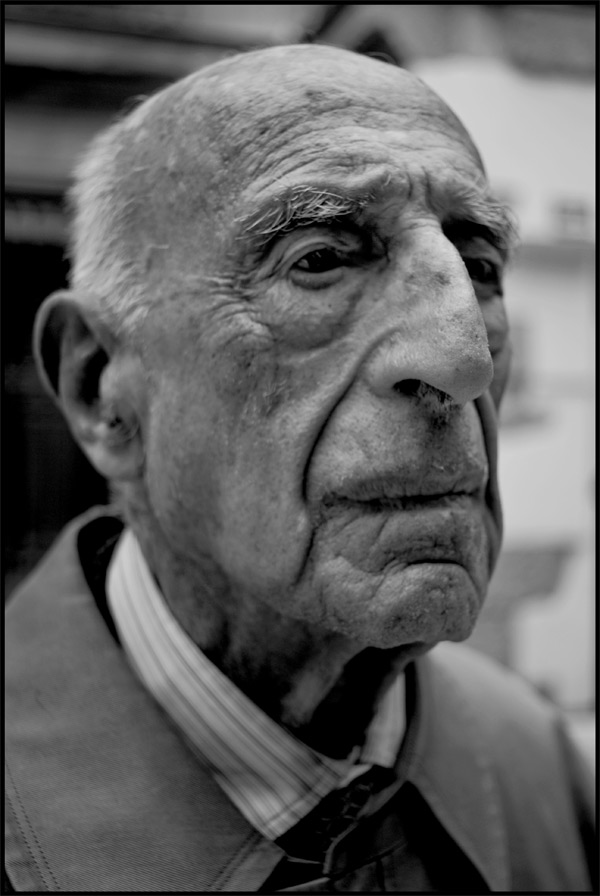 Gillo Dorfles, Madrid, 2008.
Gillo Dorfles, Madrid, 2008.
IIn 2001 the Milan Padiglione d’Arte Contemporanea (PAC) paid tribute to Dorfles the painter with an exhibition entitled “Gillo Dorfles, il pittore clandestino”, curated by Martina Corgnati.
Dorfles said “I’m very strongly attached to my painting. The public think it’s a hobby, an exercise I do for fun, but for me it’s very serious. In fact, I consider myself a very important painter, but since academic commitments have taken up much of my time, I have only been able to devote myself marginally to painting. That has stopped me from becoming famous. I could have given up my academic career, but I hadn’t the courage, and went for a safe job. That was a mistake, although I say it with hindsight. I’m convinced that had I fully devoted myself to painting, it would have made me a billionaire. My paintings would be worth hundreds of thousands of euro today; but things have turned out differently (2)”
In 1948 he set up MAC (Movimento d'Arte Concreta) with Soldati, Munari and Monner. “I think MAC was a quite important episode. Together with the Forma group, Spatialism, the Movimento Nucleare, and a few others, it represented the awakening of the Italian avant-garde after World War II. We were aiming for an art that used primordial forms that had never been seen before, had no more or less hidden anchors to naturalism, were free of symbolism and formal abstractionism, and were based only on objectivising the artist’s personal intuition.
Today, nothing remains of that experience, except what was said about it at the time. Officially, the MAC lasted for ten years from 1948 to 1958. During those years there were many exhibitions and many catalogues were published, which in historical terms now constitute a complete corpus of reference material.But today, something like the MAC would have no raison d’être. The art that has become established since then started, not surprisingly, from completely different assumptions: I'm thinking of Arte Informale, Pop Art, Hyper-realism, Body Art. The Arte Concreta movement belongs to its own time (3)”.
I went to call on Dorfles at his home one dull Milan October afternoon, in a house in Piazza Lavater, crammed with books and geologically sedimented with the layers of his life.I’m extremely vain and always have been. Vanity’s something that ought to diminish or disappear with maturity and old age, but in my case it has only intensified with the passing years
His personal tastes were evident: the modern mixed with memory, art with souvenirs. He received me in the living room. In front of the divan was a carpet that had been made to a lively design of his own; on one of the low tables was an ever-filled bowl of chocolates he was careful to offer me, as he insisted I accept a liqueur. As I was leaving, he paused to point out, among the books on a shelf, caressing it with his hand, a small marble sculpture by Angelo Mangiarotti. Of the furnishings in his apartment he has said:
”Choosing certain items rather than others obviously reflects my own aesthetic universe. For all their variety, my aesthetic values can be summed up in a single commandment: to surround myself only with things I like, that I'm fond of, and that I need. True to this idea, I live among spontaneously different styles and eras, classic pieces mixed with other more modern things.”
But I do so without obeying taste rules and ignoring carefully-planned arrengements or artificially composed anachronisms. Each item, including some less obvious ones, fits into my personal journey through the universe of taste, and comes out as a kind of individual, unique eclecticism. Along the way, as well as paintings, sculptures and other revealing traces of my aesthetic inclinations, there are various things that indicate my interest in industrial design, in which there is a clear preference for objects in which creativity and functionality coexist harmoniously (4).”
Discussing the question of the domestic scene in Dorfles e Dintorni (Ibid.) he said: “my own ideal house would be very old and quiet with a large garden, close to an urban centre and well connected. But ideals do not exist… Where and how people live is one of my greatest curiosities. But there are not many houses I would like to own myself. I was in Versace’s apartment a couple of times, before he died. It took up a whole floor of a building in Via del Gesù. An historic building with many rooms full of antique furniture, some of great value, and collections of chinaware, and silverware of excellent quality but overall, everything was in poor taste.
Mostly I find the homes of the rich Milan bourgeoisie unpleasant: there are large tables with beautiful tablecloths and wonderful china, but in bad taste. Only a few manage to escape this, and they are the authentic ones that were inherited, along with everything they contained. Anyway I wouldn’t ever want to live in places like that, even if I did inherit them nor do I like those homes of architects or designers, that pose as the very latest thing.
They irritate me in exactly the same way; I can’t stand rooms that are hardly lived in, that only have a Barcelona chair because it’s Mies, not because it’s comfortable, if you see what I mean. So there aren’t many houses that make me envious. To say nothing of those deliberately squalid New York lofts, or apartments lived in by a certain kind of old lady, scattered about with photographs from their past, and souvenirs they gathered up when travelling. And then those homes of rich Americans, where the lady of the house receives visitors in the kitchen.
The kitchen opens into the living room, so that the hostess can continue cooking whilst her guests sit in the main room. People like that think it’s a more open, more informal arrangement, but the ridiculous thing is that since those are big houses with two floors, there’s absolutely no reason to justify not making the kitchen a self-contained room. I love cooking, but it’s a private thing like going to the bathroom, not something to share. Naturally if it’s a small place, and you’re cooking for a guest, it makes sense for them to come into the kitchen, but there’s a certain kind of pretentious home where it doesn’t make any sense to me (5).”
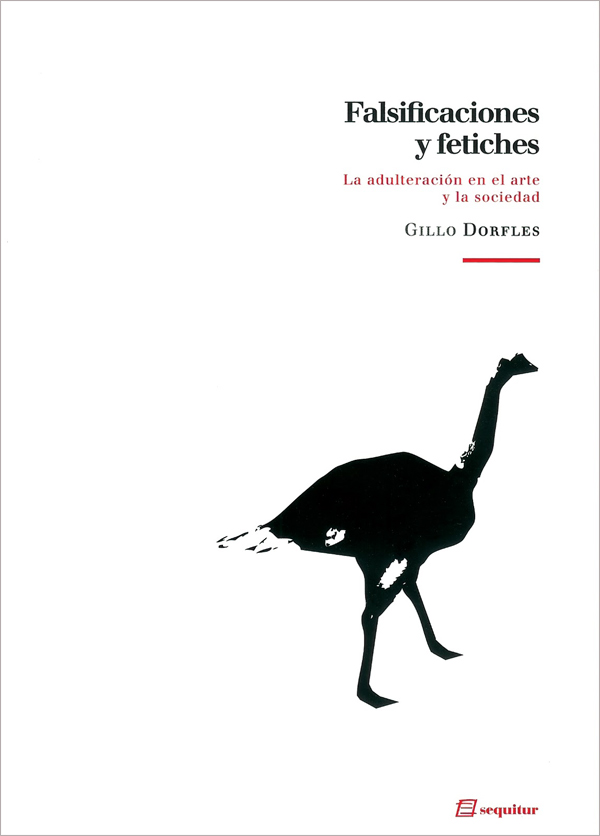 Book cover, Falsificaciones y fetiches, by Gillo Dorfles.
Book cover, Falsificaciones y fetiches, by Gillo Dorfles.
His way of dressing is also personal: warm tones all the time, and classic, comfortably cut clothes in unusual combinations of fabrics and colours that are sometimes adventurous, but never loud. He has a fondness for browns, yellows, and oranges. I've never seen him in the standard dark blue suit and blue shirt. He cares about elegance and doesn’t make a secret of it.
“I wouldn’t say it’s everything, but I do think elegance is very valuable. Ever since I was a child I’ve got the greatest pleasure out of getting dressed, and picking out one garment rather than another, or choosing what colour to wear. Over the years I've tried, unsuccessfully, to control this narcissistic trend in myself, and still today if I happen to pass by a shop and see a scarf and sweater I like, I want to go in and buy them. For me elegance, or even only taking an interest in how people dress, is an essential part of our aesthetic upbringing, or to put it in a different way, dressing is an art form. Unless it’s a matter of sexual excitement, when men and women are naked and not wearing clothes, they’re anything but attractive.
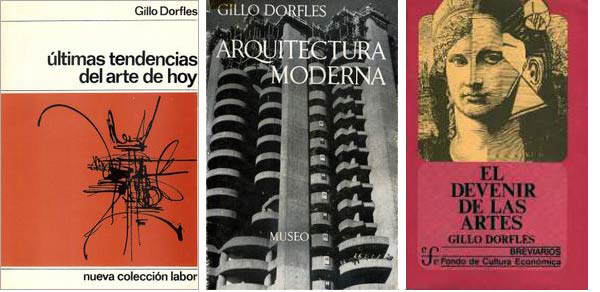 Book covers (left to right): Últimas tendencias del arte de hoy, Árquitectura moderna and El devenir de las artes, by Gillo Dorfles.
Book covers (left to right): Últimas tendencias del arte de hoy, Árquitectura moderna and El devenir de las artes, by Gillo Dorfles.
Actually, I'd say that if they’re not wearing clothes, human beings have no existence. It’s no coincidence that right from the start, homo sapiens has always put great effort into covering himself up. Refinement in one’s choice of clothing is clearly an expression of vanity, so I confess it: I’m extremely vain and always have been. Vanity’s something that ought to diminish or disappear with maturity and old age, but in my case it has only intensified with the passing years (6).”
When was five or six I had to wear “sailor” smocks in a certain style, made of dark blue cloth with a big wide collar, and the all-important white five-pointed star. But what I was especially proud of was that these famous smocks hadn’t just been bought in any old shop in Genoa, where I grew up, but came directly from Livorno, where the real Naval Academy was. I could instantly tell the difference between Livorno Blue and any other blue, and would pick it out straight away, any time I came upon another boy in the street who was also dressed “alla marinara.”
This brief and fatuous confession of mine is not so that I can show off about my precocious fashion sense, or my ability to tell one colour from another, but only as my way of saying that the importance of wearing a particular piece of clothing rather than another, has always been congenial to me.
I've always believed that what we choose to wear, and how that relates to some very profound aspects of what we are (our changes of mood, our way of presenting ourselves to the world) mustn’t be left out of the account. It’s very important, and I don’t mean only for me, but for other people as well. So now and again when asked, it makes sense for me to accept invitations to speak and write on the subject of fashion (7).”
I've always believed that what we choose to wear relates to some very profound aspects of what we are, our changes of mood, our way of presenting ourselves to the worldHis vast output includes two perceptive books about fashion: Mode & Modi (1979, Mazzotta, Milan) and La Moda della Moda (1984, Costa & Nolan, Genova).
And many of his essays frequently touch on fashion and fashions, so when it comes to his personal vanity, he is more than ready to talk. “I have to confess that if I find an attractive label on a raincoat or winter jacket after I've bought it, that gives me deep satisfaction even if it’s fake, and even if a pair of shoes aren’t Church's, or a pullover isn’t Cardin or Missoni. I have to admit to another little weakness: I remove all these labels, so that none of my clothes have the same labels as everyone else’s. That may be a good thing or a bad thing, but I always want to avoid having the same stamp on me that everyone else has (8).”
He is also interested in other peoples’ dress sense; his inquisitiveness about it is not simply scholarly curiosity, but is almost feminine in its complicity. I remember he once asked me to tell him why I was wearing a long white shirt outside my trousers, along with a short waistcoat. I said that was the fashion, as suggested by the designer Romeo Gigli. As we exchanged compliments with each other on how well-dressed we both were, he confessed that the source of his elegance was a wardrobe that was still full of tailor-made clothes.
He regards fashion as a phenomenon that is becoming more and more relevant; he researches it with unusual skill and the genuine passion of the stylish dresser.
“Although It’s excellent that fashion is becoming more and more important, not least in economic terms, that doesn’t protect it from the risk of standardisation. Keeping up with trends has forced the fashion industry to adopt rhythms and methods of production and organisation that can subordinate real creativity to the much more mechanical and promotional logic of brands. Fashion shows nowadays always go for deliberate provocation, just for the sake of it, and for designs that often seem intentionally unwearable. But although exhibitionism in fashion often seems to be taking over from ispirational quality, product design and fashion are still two of the very few areas where creativity always manages to infiltrate and break in (9).”
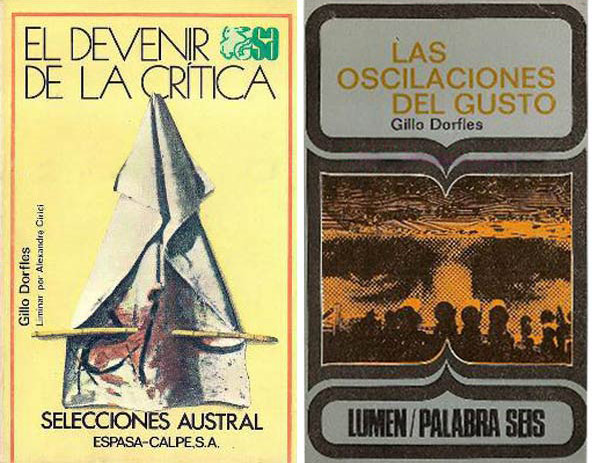 Book cover El devenir de la crítica (left). Book cover, Las oscilaciones del gusto (right) by Gillo Dorfles.
Book cover El devenir de la crítica (left). Book cover, Las oscilaciones del gusto (right) by Gillo Dorfles.
As a way of opening my conversation with him, it comes naturally for me to mention this year’s Venice Architecture Biennale, curated by Aaron Betsky and still running. I congratulate him on the lucidity of his review in Il Corriere della Sera of last September 18th., saying that when one has doubts, it’s reassuring to know they are shared by others who are more authoritative.
He wrote “I don’t deny that Betsky’s intentions were good: to set architecture free as an art form, so that it isn’t only analysed in terms of finished buildings, and making it possible to go back over some of the most important germinating moments of all architecture. But I only approve of it on condition that it doesn’t lead to the renewal of a vacuous ‘valérianism’ (obviously I mean Paul Valéry’s Eupalinos) according to which architecture is merely frozen music. In my opinion it is highly dangerous to wander in that idealistic realm of the so-called ‘dawn of architecture’ instead of analysing and judging the real thing, beginning from the project, and going all the way through to final completion of this ‘art form’, which I put in quotation marks to emphasise that we should not confuse architecture, as too often happens, with the languages of other arts.
We have a clear example of it in this Biennale, with many installations, videos, and sculptural shapes that are very far away from an architectural language, and much closer to the languages of the other visual arts, but that remain at the level of the 'formal embryo' – often suggestive, but hardly ever persuasive. So traipsing around the endless spaces of the Arsenale and the Giardini, one is left in no doubt that many of the exhibits and installations suggest an art Biennale, rather than an exhibition about architecture. Nevertheless, this year’s edition can have a useful salutory role, if nothing else to warn us against an excessive glorification of today's would-be futuristic design, which all too often is nothing more than an advertisement for itself.” To this article he adds “there’s too much formalism in architecture. Frank Gehry is formidable, but beware of his imitators! What we’re seeing is an abuse of the idea of the exceptionally important building (10).”
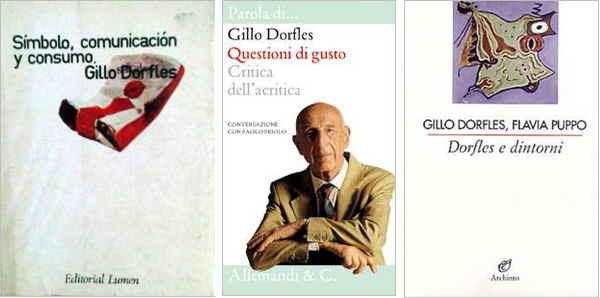 Book cover (left to right): Símbolo, comunicación y consumo, Quistioni di gusto and Dorfles e dintorni, by Gillo Dorfles.
Book cover (left to right): Símbolo, comunicación y consumo, Quistioni di gusto and Dorfles e dintorni, by Gillo Dorfles.
(1). Puppo, Flavia; Dorfles, Gillo. Dorfles e dintorni, Archinto: Milán/ MIlan, 2003.
(2). Questioni di Gusto: Critica dell’acritica. Conversazione con Paolo Priolo. Turín/ Turin: Allemandi & Co, 2008.
(3). Ibid.
(4). Ibid.
(5). Dorfles e dintorni, Ibid.
(6). Ibid.
(7). La Moda della Moda, Milán/ Milan: Costa&Nolan, 1984.
(8). Conformisti, Roma/ Rome: Donzelli Editore, 1997.
(9). Questioni di Gusto, Ibid.
(10). Corriere della Sera, 18 de septiembre.
Article published in Experimenta 62, titled Gillo Dorfles.

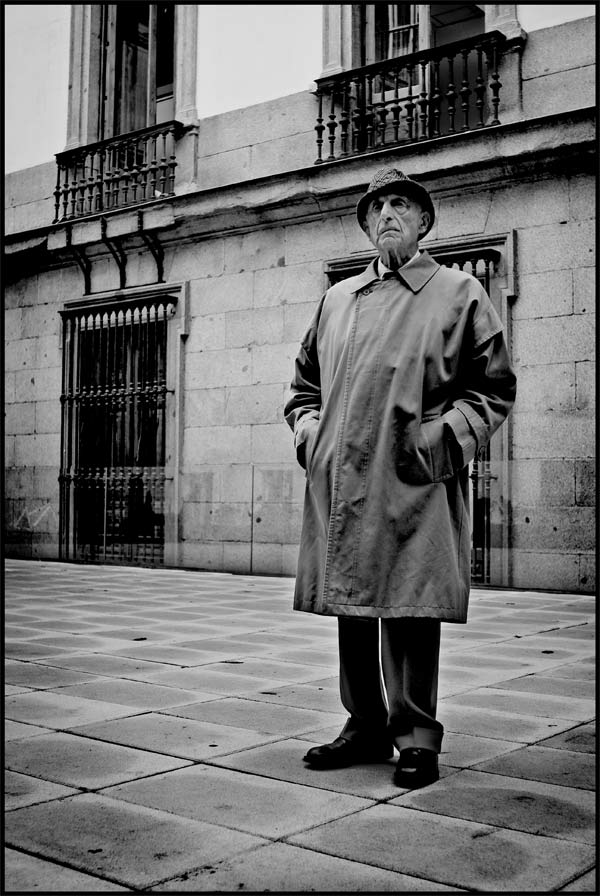







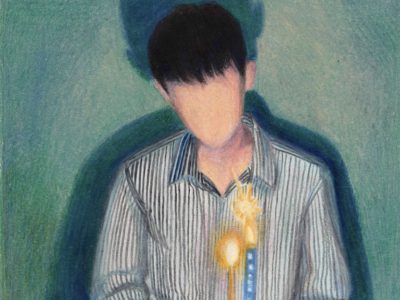

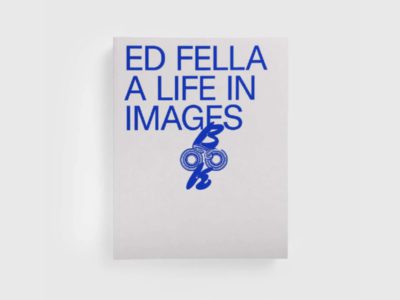
Many thanks for a very interesting interview. I have seen works by Gillo Dorfles in Italy or Brussels (if I am not mistaken) a long long time ago. I was very intrigued with Dorfles’ art but I have never managed to see his works again, not even online. Can you please let me know if there is a specific site to Gillo’s works?
best regards
Ray Piscopo
MALTA
http://www.piscopoart.com